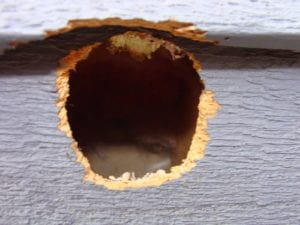
by Pigeon Patrol | Apr 1, 2020 | 4-S Gel Bird repellent, Animal Deterrent Products, Bird Deterrent Products, Bird Netting, Bird Spike, Bird Spikes, Pigeon Control, Pigeon Droppings, Pigeon Patrol's Services, Pigeon Spikes, Pigeons in the News, UltraSonic Bird Control
There are top 3 woodpeckers problems 
Woodpecker Problem #1 – The most commonly given reason for woodpeckers hammering on your home is that they are searching for food, however this is NOT correct. Woodpeckers are most likely not searching for food when hammering on your house. If you have wood shingles, you may want to have an inspector look for insect problems, but it is unlikely an insect problem that you have could be a woodpecker food source.
Woodpecker Problem #2 – Woodpeckers are hammering (or drumming) to announce their territory, much like a cardinal singing his song i
in spring. The drumming is loud, but generally not very destructive or as long-lived in duration as the third reason. This is most common in late winter and through the breeding season, i.e. late-February though June.
Solution: This kind of activity can best be stopped by making the drumming site unsuitable for noisemaking. This can be done by covering it with noise-deadening material such as canvas, foam rubber, a sheet, newspaper, heavy plastic, or ¾ inch bird netting attached to the building across the focal area. For specific exclusion methods, see Woodpecker Exclusion Method section below.
Woodpecker Problem #3 – The third reason entails the real “nuisance” issue. It is called excavating (or chiseling) whereby either a male or a female constructs a nest or roost hole with a cavity that would typically be placed in trees. This is the most common cause of damage and can be very destructive. If you see a hole at least 2 inches in diameter, you most likely have a woodpecker that is excavating a nesting cavity. Unfortunately, some woodpeckers try to place such a cavity in the side of a house, barn, utility pole, fence post, or other man-made structure.
Solution: Problems of this nature may be avoided by leaving dead snags or by hanging woodpecker nest boxes. Installing a bird box, much like a bluebird or purple martin box, at the site of excavation with either deter the bird or it will use the box for nesting. Many stores sell bird boxes for those not choosing to build their own. For other exclusion methods, see following section.
Source
At Pigeon Patrol, we manufacture and offer a variety of bird deterrents, ranging from Ultra-flex Bird Spikes with UV protection, Bird Netting, 4-S Gel and the best Ultrasonic and audible sound devices on the market today.
Contact us at 1- 877– 4– NO-BIRD, (604) 585-9279 or visit our website at www.pigeonpatrol.ca
Bird Gone, Pigeon Gone, Seagull Gone, Pigeon issue, pigeon spikes, 1-877-4NO-BIRD, 4-S Gel, Bird Control, Pigeon Control, bird repellent, Bird Spikes, sonic bird repellent, stainless steel bird spikes, bird spikes Vancouver, Ultra Sonic Bird Control, Bird Netting, Plastic Bird Spikes, Canada bird spike deterrents, Pigeon Pests, B Gone Pigeon, Pigeon Patrol, pest controller, pest control operator, pest control technician, Pigeon Control Products, humane pigeon spikes, pigeon deterrents, pigeon traps, Pigeon repellents, Sound & Laser Deterrents, wildlife control, raccoon, skunk, squirrel deterrent, De-Fence Spikes, Dragons Den, Canada bird spikes, Canada pigeon, pigeon control, pigeon patrol, pigeon. Kill pigeons, crow, starling
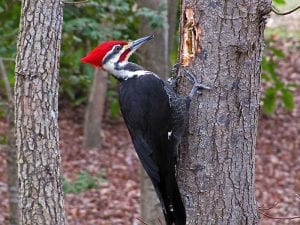
by Pigeon Patrol | Apr 1, 2020 | 4-S Gel Bird repellent, Animal Deterrent Products, Bird Deterrent Products, Bird Netting, Bird Spike, Bird Spikes, Pigeon Control, Pigeon Droppings, Pigeon Patrol's Services, Pigeon Spikes, Pigeons in the News, UltraSonic Bird Control
How to prevent woodpeckers from damaging your home? Here are some tips on how you can get rid of woodpeckers and other insects near your home if they become problematic and pose high risks.
- Remove prune branches or large trees near your home and on areas where they peck so that they will be encouraged to stay in a thicker cover because they will feel more exposed and vulnerable when you remove the trees. As a result, they will be redirected and will be discouraged to peck your home.
- Provide an easier food source to them instead of allowing them to find insects on your home. Jelly, Suet, and mealworms are some of the food sources that you can consider.
- Give them a ready-made cavity by creating a birdhouse for them, especially if their activity is a prelude to nesting. Place it near or over the area where the pecking has occurred.
- Replace shingles or use wood putty to cover the holes that are already drilled woodpeckers.
- Prevent any insects from invading the weakened area and disguise the site by painting or staining the repair over.
- If the woodpecker activity becomes out of control or insects are already feeding on the wooden structure of your home, it is better for you to hire pest control professionals to inspect your home. Woodpeckers will feed somewhere else if insects will be eliminated.
If these simple redirection strategies still don’t work, here are some stronger way to get rid of them completely:
- Add reflective objects that are bright enough to scare them away. Wind chimes and recorded bird alarms can also help to scare them.
- Wooden areas where they find it attractive to peck can be covered with netting, cloth, or foam. Fishing line or chicken wires can also be added, 1-2 inches away from the surface to keep them from reaching the wooden structure of your home.
- Use decoys such as carved or plastic owls and hawks can also be placed on areas where they are pecking so they can be deterred.
Source
At Pigeon Patrol, we manufacture and offer a variety of bird deterrents, ranging from Ultra-flex Bird Spikes with UV protection, Bird Netting, 4-S Gel and the best Ultrasonic and audible sound devices on the market today.
Contact us at 1- 877– 4– NO-BIRD, (604) 585-9279 or visit our website at www.pigeonpatrol.ca to prevent woodpeckers from damaging your home
Bird Gone, Pigeon Gone, Seagull Gone, Pigeon issue, pigeon spikes, 1-877-4NO-BIRD, 4-S Gel, Bird Control, Pigeon Control, bird repellent, Bird Spikes, sonic bird repellent, stainless steel bird spikes, bird spikes Vancouver, Ultra Sonic Bird Control, Bird Netting, Plastic Bird Spikes, Canada bird spike deterrents, Pigeon Pests, B Gone Pigeon, Pigeon Patrol, pest controller, pest control operator, pest control technician, Pigeon Control Products, humane pigeon spikes, pigeon deterrents, pigeon traps, Pigeon repellents, Sound & Laser Deterrents, wildlife control, raccoon, skunk, squirrel deterrent, De-Fence Spikes, Dragons Den, Canada bird spikes, Canada pigeon, pigeon control, pigeon patrol, pigeon. Kill pigeons, crow, starling
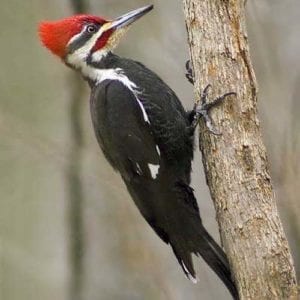
by Pigeon Patrol | Apr 1, 2020 | 4-S Gel Bird repellent, Animal Deterrent Products, Bird Deterrent Products, Bird Netting, Bird Spike, Bird Spikes, Pigeon Control, Pigeon Droppings, Pigeon Patrol's Services, Pigeon Spikes, Pigeons in the News, UltraSonic Bird Control
Woodpeckers usually hammer on houses for one of four reasons:
- Because it makes a satisfyingly loud noise that proclaims the bird’s territory and attracts a mate. If the birds are drumming for these reasons, they will most likely stop once breeding has begun in the spring (they don’t drum when looking for food).
- Because the bird wants to excavate a nest or roost hole. If the woodpeckers are creating a nest cavity, the hole will be round and large. Nesting holes are usually built in the beginning of the breeding season between late April and May. If you need to evict woodpeckers from your home, aim to do so either before or after the nesting season.
- Because it is feeding on insects living in the siding. If the birds are looking for insects, the holes will be small and irregular. You may have to call an exterminator to get rid of the underlying insect problem. Woodpeckers are particularly fond of the larvae of carpenter bees, leafcutter bees, and grass bagworms. .
- Because they are storing food. If you are located in the West, Acorn Woodpeckers peck dozens or hundreds of acorn-sized holes into large trees or houses, and stash a single fresh acorn into each one.

Source
At Pigeon Patrol, we manufacture and offer a variety of bird deterrents, ranging from Ultra-flex Bird Spikes with UV protection, Bird Netting, 4-S Gel and the best Ultrasonic and audible sound devices on the market today.
Contact us at 1- 877– 4– NO-BIRD, (604) 585-9279 or visit our website at www.pigeonpatrol.ca for any woodpeckers hammer problems
Bird Gone, Pigeon Gone, Seagull Gone, Pigeon issue, pigeon spikes, 1-877-4NO-BIRD, 4-S Gel, Bird Control, Pigeon Control, bird repellent, Bird Spikes, sonic bird repellent, stainless steel bird spikes, bird spikes Vancouver, Ultra Sonic Bird Control, Bird Netting, Plastic Bird Spikes, Canada bird spike deterrents, Pigeon Pests, B Gone Pigeon, Pigeon Patrol, pest controller, pest control operator, pest control technician, Pigeon Control Products, humane pigeon spikes, pigeon deterrents, pigeon traps, Pigeon repellents, Sound & Laser Deterrents, wildlife control, raccoon, skunk, squirrel deterrent, De-Fence Spikes, Dragons Den, Canada bird spikes, Canada pigeon, pigeon control, pigeon patrol, pigeon. Kill pigeons, crow, starling
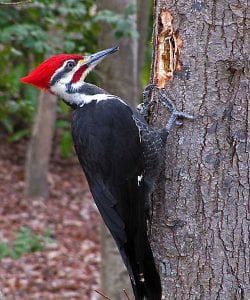
by Pigeon Patrol | Apr 1, 2020 | 4-S Gel Bird repellent, Animal Deterrent Products, Bird Deterrent Products, Bird Netting, Bird Spike, Bird Spikes, Pigeon Control, Pigeon Droppings, Pigeon Patrol's Services, Pigeon Spikes, Pigeons in the News, UltraSonic Bird Control
Once you know why woodpeckers are hammering on your house, you can develop strategies for stopping them. Take a look at Can Woodpecker Deterrents Safeguard My House? for ideas on how to deal with troublesome woodpeckers.
Researchers at the Lab of Ornithology have performed studies relating nuisance woodpeckers. One study, External characteristics of houses prone to woodpecker damage, found that lighter colored aluminum and vinyl sidings are less likely to be damaged by woodpeckers. Another paper, Assessment of Management Techniques to Reduce Woodpecker Damage to Homes, tested six common long-term woodpecker deterrents: life-sized plastic owls with paper wings, reflective streamers, plastic eyes strung on fishing line, roost boxes, suet feeders, and a sound system which broadcasts woodpecker distress calls followed by the call of a hawk. Researchers found that nothing deterred woodpeckers all the time, and only the streamers worked with any consistency.
Homeowners have reported some success deterring woodpeckers with windsocks, pinwheels, helium balloons (shiny, bright Mylar balloons are especially effective), strips of aluminum foil, or reflective tape. Other people keep woodpeckers away by covering an affected area with burlap or attaching bird netting (the kind designed for gardens and fruit trees) from overhanging eaves to the siding. If you use netting, make sure it is taut and set at least 3 inches from the siding to avoid birds pecking through it. Close off openings on the sides to prevent birds from becoming trapped between the netting and the house.
You may also want to plug the holes with wood putty to discourage further activity. If a woodpecker has dug a roost hole into your house, make sure there are no birds inside before sealing it up.
Never use any sticky “repellent,” such as Tanglefoot Pest Control, Roost-No-More, or Bird Stop, outdoors. These types of products can fatally injure birds and other animals.
Source
At Pigeon Patrol, we manufacture and offer a variety of bird deterrents, ranging from Ultra-flex Bird Spikes with UV protection, Bird Netting, 4-S Gel and the best Ultrasonic and audible sound devices on the market today.
Contact us at 1- 877– 4– NO-BIRD, (604) 585-9279 or visit our website at www.pigeonpatrol.ca
Bird Gone, Pigeon Gone, Seagull Gone, Pigeon issue, pigeon spikes, 1-877-4NO-BIRD, 4-S Gel, Bird Control, Pigeon Control, bird repellent, Bird Spikes, sonic bird repellent, stainless steel bird spikes, bird spikes Vancouver, Ultra Sonic Bird Control, Bird Netting, Plastic Bird Spikes, Canada bird spike deterrents, Pigeon Pests, B Gone Pigeon, Pigeon Patrol, pest controller, pest control operator, pest control technician, Pigeon Control Products, humane pigeon spikes, pigeon deterrents, pigeon traps, Pigeon repellents, Sound & Laser Deterrents, wildlife control, raccoon, skunk, squirrel deterrent, De-Fence Spikes, Dragons Den, Canada bird spikes, Canada pigeon, pigeon control, pigeon patrol, pigeon. Kill pigeons, crow, starling
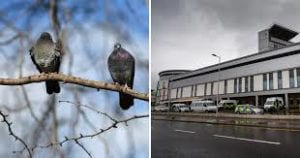
by Pigeon Patrol | Mar 16, 2020 | 4-S Gel Bird repellent, Animal Deterrent Products, Bird Deterrent Products, Bird Netting, Bird Spike, Bird Spikes, Pigeon Control, Pigeon Droppings, Pigeon Patrol's Services, Pigeon Spikes, Pigeons in the News, UltraSonic Bird Control
Revival of the Passenger Pigeon? Not to be confused with the carrier pigeon (a domesticated bird trained to transport messages), the passenger pigeon is believed to have constituted 25 to 40 percent of the total U.S. bird population at one time. Its main nesting area was in the region of the Great Lakes and east to New York, where it relied on mixed hardwood forests to protect and sustain its massive flocks of up to 5 million birds at a time on a diet of beechnuts, acorns, chestnuts, seeds and berries, along with worms and insects in the spring and summer. Passenger pigeons built low-hanging, flimsy nests that often left eggs on the ground, but were able to successfully reproduce thanks to their sheer numbers: Predators such as raccoons, foxes, possums, hawks, eagles and snakes could gorge themselves on pigeon eggs without exhausting the supply.
This system, known as “predator satiation,” quickly broke down when humans became the species’ primary predator. Though humans had long used passenger pigeons for food to some extent, and farmers had killed them for causing damage to crops in such huge numbers, this didn’t reduce their numbers–until a mass slaughter by professional hunters began in the 1800s. Ironically, the birds were particularly vulnerable to such hunting because they nested in such large numbers. With no laws restricting the number of pigeons killed or the way they were taken, hunters placed baited traps or decoys, shot at nesting sites, knocked the birds out of their nests with long sticks or placed pots of burning sulphur under the trees so that fumes would daze the pigeons and cause them to drop out of their nests.
By the 1850s, hundreds of thousands of passenger pigeons were being killed for private consumption or sale, sometimes for as little as 50 cents a dozen. The cheap pigeon meat was fed to slaves, among others. By 1860, people noticed that the number of passenger pigeons had decreased, but no action was taken to stop the mass killing. Passenger pigeons had largely disappeared from American skies by the early 1890s, and the last known sighting in the wild occurred in 1900. “Martha,” the last known surviving passenger pigeon, lived all of her 29 years at the Cincinnati Zoological Society. After her death in 1914, she was frozen into a 300-pound block of ice and shipped to the Smithsonian Institution, where she was mounted for display as part of the museum’s bird collection, one of the largest in the world.
Now, nearly a century after Martha’s death, scientists believe they can bring her species back to life, using techniques worthy of the 1990s science-fiction/action blockbuster “Jurassic Park.” With funding from Revive and Restore, a group dedicated to the de-extinction of recently lost species, the young biologist Ben J. Novak is spearheading efforts to use DNA taken from passenger pigeon specimens in museums and fill it in with fragments from a living species, the band-tailed pigeon. The reconstituted genome would then be inserted into a band-tailed pigeon stem cell, creating a germ cell (an egg-and-sperm precursor). When the germ cell is injected into young band-tailed pigeons and these pigeons reproduce, their offspring would come as close as possible to expressing the passenger pigeon genes. The “de-extinction” process is different from cloning, in that it uses a variety of DNA from different passenger pigeons, meaning that the offspring produced would be as unique as any bird from an original passenger pigeon flock.
Most experts acknowledge that recreating the passenger pigeon in this way is technically possible, based on the success scientists have had mapping the woolly mammoth genome by using elephant DNA, among other experiments. But significant challenges still exist, particularly when it comes to reintroducing the passenger pigeon into the wild, given the vastly different ecosystem it would encounter in the modern world. Much of the bird’s breeding and wintering habitats are gone due to deforestation, and its primary breeding season food (beech mast, the nuts of a beech tree) now exists only in limited quantities. And with likely flocks of only a few thousand of the new pigeons (as opposed to 5 million) the species’ mass tactics of survival wouldn’t be able to protect them from predators.
Novak, for one, told the Washington Post that he believes people are sufficiently committed to the de-extinction of the passenger pigeon to overcome such obstacles. History may help his cause, as the extinction of the passenger pigeon did play a significant role in arousing public interest in the need for stronger conservation laws. In any case, only time will tell, as scientists estimate it will take at least a decade to produce a flock of new passenger pigeons large enough to release into the wild.
Source
At Pigeon Patrol, we manufacture and offer a variety of bird deterrents, ranging from Ultra-flex Bird Spikes with UV protection, Bird Netting, 4-S Gel and the best Ultrasonic and audible sound devices on the market today.
Contact us at 1- 877– 4– NO-BIRD, (604) 585-9279 or visit our website at www.pigeonpatrol.ca
Bird Gone, Pigeon Gone, Seagull Gone, Pigeon issue, pigeon spikes, 1-877-4NO-BIRD, 4-S Gel, Bird Control, Pigeon Control, bird repellent, Bird Spikes, sonic bird repellent, stainless steel bird spikes, bird spikes Vancouver, Ultra Sonic Bird Control, Bird Netting, Plastic Bird Spikes, Canada bird spike deterrents, Pigeon Pests, B Gone Pigeon, Pigeon Patrol, pest controller, pest control operator, pest control technician, Pigeon Control Products, humane pigeon spikes, pigeon deterrents, pigeon traps, Pigeon repellents, Sound & Laser Deterrents, wildlife control, raccoon, skunk, squirrel deterrent, De-Fence Spikes, Dragons Den, Canada bird spikes, Canada pigeon, pigeon control, pigeon patrol, pigeon. Kill pigeons, crow, starling
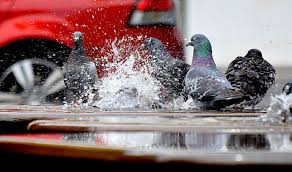
by Pigeon Patrol | Mar 16, 2020 | 4-S Gel Bird repellent, Animal Deterrent Products, Bird Deterrent Products, Bird Netting, Bird Spike, Bird Spikes, Pigeon Control, Pigeon Droppings, Pigeon Patrol's Services, Pigeon Spikes, Pigeons in the News, UltraSonic Bird Control
Japanese pigeon skips local race, lands on Vancouver Island instead
A Japanese racing pigeon truly went the distance, after he overshot a 1,000-kilometre race in his native country and instead traveled across the Pacific Ocean and ended up on Vancouver Island.
The remarkable bird was tracked back to Japan, where he was released May 10 in the northern province of Hokkaido to take part in a local race.
The one-year-old bird was set to compete along with 8,000 other pigeons in his native land, but instead was discovered on June 6 at Canadian Forces Base Comox near Courtenay, B.C.
The bird was turned over to the Mountainaire Avian Rescue Society, where staff nursed him back to health.
Maj Birch, founder and manager of MARS, told CTVNews.ca Friday that the male bird was very ill.
“He was very weak, very thin and we did a test and found that he had a very heavy parasite load,” she said, adding that the bird was treated with a combination of fluids, food and medication.
Birch said she is not sure how the pigeon was able to make the trans-Pacific crossing, or which route he took. She added that this is not the first bird from Japan to end up on British Columbia’s shores.
“We don’t actually know whether he took that route or whether he managed to catch a freighter or several freighters” she said.
“There’s no way of knowing that, so we can only imagine that he had a wonderful journey,” she said with a laugh. “Because he was found at our air force base, maybe he rode the plane.”
Thanks to a tag on the bird’s leg, the society was able to identify and later contact the owner of the champion pigeon.
Owner Hiroyasu Takasu said he was shocked to hear the bird had survived.
“(Birds) usually reach their limit in a week, with no food or water. This is a superior pigeon,” he told ABC News.
He noted that only around 20 per cent of the birds that raced last month were able to finish the race.
He added that the bird was never given a name, because pigeons are only named after they return home.
However, Takasu declined to have the bird returned to Japan by plane, citing fears that excessive travel might put added strain on its health.
This led to some initial searching to find the pigeon a home, as he is essentially considered an “illegal alien” who arrived on Canadian shores without being imported, Birch said.
“I was concerned that there may be issues in trying to find a home for him here,” she said, adding that the society is not a sanctuary but a rehabilitation centre.
Luckily, an official with the Mid-Island Racing Club in Nanaimo, B.C. has agreed to adopt the bird. The club is reportedly considering breeding it to produce more “superior” pigeons.
This may be a smart move, as it was the pigeon mother who reportedly won the local Japanese race.
Source
At Pigeon Patrol, we manufacture and offer a variety of bird deterrents, ranging from Ultra-flex Bird Spikes with UV protection, Bird Netting, 4-S Gel and the best Ultrasonic and audible sound devices on the market today.
Contact us at 1- 877– 4– NO-BIRD, (604) 585-9279 or visit our website at www.pigeonpatrol.ca
Bird Gone, Pigeon Gone, Seagull Gone, Pigeon issue, pigeon spikes, 1-877-4NO-BIRD, 4-S Gel, Bird Control, Pigeon Control, bird repellent, Bird Spikes, sonic bird repellent, stainless steel bird spikes, bird spikes Vancouver, Ultra Sonic Bird Control, Bird Netting, Plastic Bird Spikes, Canada bird spike deterrents, Pigeon Pests, B Gone Pigeon, Pigeon Patrol, pest controller, pest control operator, pest control technician, Pigeon Control Products, humane pigeon spikes, pigeon deterrents, pigeon traps, Pigeon repellents, Sound & Laser Deterrents, wildlife control, raccoon, skunk, squirrel deterrent, De-Fence Spikes, Dragons Den, Canada bird spikes, Canada pigeon, pigeon control, pigeon patrol, pigeon. Kill pigeons, crow, starling







